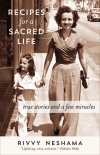Recipes for a Sacred Life: True Stories and a Few Miracles Rivvy Neshama (best short books to read .TXT) 📖

- Author: Rivvy Neshama
Book online «Recipes for a Sacred Life: True Stories and a Few Miracles Rivvy Neshama (best short books to read .TXT) 📖». Author Rivvy Neshama
That was no big deal since sheep are found all over England, where they’re said to outnumber people. One autumn, while hiking in Shropshire, we wandered into a flock of them. They stared at us, and we stared back. Then I started to sing softly so they wouldn’t be afraid. A few were still scared and walked off, one after the other, sheep-like. But they kept turning to look back, as curious as we were.
Sheep aren’t the only animals I’ve reached out to.
After reading a book that said we can communicate with all species, I tried it first with bugs. I’d ask certain flies to alight on my hand and stand still—and they would! I could see their antennas going, boom, boom, and for the first time I felt there was spirit in those flies, who were looking at me as surely as I was looking at them.
I do believe it’s possible to converse with all animals, perhaps more telepathically than verbally. The first time John and I went hiking in Hall Ranch, in the mountains near Lyons, Colorado, we were expecting to see an abundance of wildlife since it offered new trails and had long been left wild. Yet in two hours of hiking, we saw nothing but trees, even when we stood still and were quiet. So I called out to the wild ones, silently, asking them to join us. Within minutes, we spotted a lizard, a snake, a rabbit . . . and then a herd of deer ran leaping along the red cliffs above us. My heart leapt too.
I’ve also noticed that when John goes off traveling or I’m facing some crisis, the neighborhood deer come to sleep on our lawn. I’m not aware that I’ve called them, yet they come, like a faithful dog that knows when it’s needed.
There are some species though—say, earwigs—that I have little interest in talking to. Especially when they enter our home. Still, I try to honor all living things, so instead of killing them, I ask them to leave, and if they don’t, I carry them out (well, have John carry them out).
If I do choose to kill, I offer an apology or prayer, the way the Indians did when they killed buffalo for meat. The Native People honor the buffalo and call him their brother. They believe we are all related, four-footed as well as two-footed creatures, along with plants and trees, sky and earth . . . and even my mean third-grade teacher, Miss Brown. All of us, linked together, in an indivisible Hoop of Life.
Nowadays, I speak to animals as much as John does. “Hi, Magpie,” I say. “Hello, Bees.” And when the deer come to graze on our lawn, I talk to them in a quiet tone as I’ve been taught you should. “No worries,” I assure them. “Glad you’re here. You can eat the grass, but stay out of the flowers.” Their ears perk up attentively, and then they eat the flowers.
ODES TO A GARDEN
SOIL TIME
I met Majid at a Sufi ceremony—a Zikr, which means remembrance, remembrance of God. We chanted and danced and whirled like dervishes, with each turn lifting us higher. Then we sat on exotic rugs and ate exotic treats: almonds and figs and pastries with honey. All in remembrance of God. Yum.
It was at a spring Zikr that I met Majid, a noble-looking man in his thirties. He had moved to Boulder from Iran and was studying to be a landscape architect. He was looking for work, and my garden was looking for help.
One week later, Majid came and transplanted some forget-me-nots from our backyard to the front so we could see those blue beauties more clearly. I helped pat down the dirt and said a blessing, “Take root and live. We love you. Be happy.”
Majid told me that Islam says whoever works in the soil is closest to Allah. He enjoys researching plants and making landscape drawings. But to feel good, he said, he needs his hands in the soil.
I feel the same. Like a kid making mud pies, I’m in bliss when my hands are in dirt—touching it, smelling its earthy smell, and watching the hidden world of worms and insects beneath. And if I’m feeling tense, there’s nothing like digging up weeds to feel clear again and present.
Soil time. Close to the earth. Closest to Allah.
PLANTING
I read a story once about a woman who moved often yet planted gardens wherever she lived. She didn’t mind that she was moving on and leaving them behind. She didn’t mind doing all that work for results she might never see. Her happiness came, she said, from making the world more beautiful.
WATERING
Every June morning, I rise early and go to the garden to water the budding flowers and newborn vegetables before the sun gets too hot. Everything is serene at this hour, as the sky slowly opens and the earth wakes up. I hold the hose and water deeply, standing still, almost in a trance. Between the rows of chard I see a neon-blue dragonfly sipping nectar from a rose. The birds are chirping, the butterflies playing, and soon I am lost in the buzz of the bees. All the world is singing, it seems, singing thank you for this day.
By late August, though, the joy of watering wears thin. “Did you water the plants?” I ask John hopefully, since it’s already 9 a.m. and the sun is getting hot. “No, I was too busy,” he says. So I stump out to the garden





Comments (0)